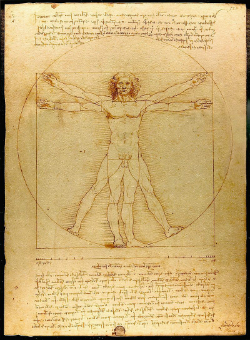O Vitruvian man or Vitruvius Man is a drawing by Leonardo da Vinci (1452-1519) that was produced in 1490, during the Renaissance.
It represents the classic ideal of beauty, balance, harmony of form and perfection of proportion. Today it is one of the best known and most reproduced works in the world.

Statue of the Vitruvian Man in Belgrave Square, London
History
Leonardo da Vinci he recorded his studies in journals, and so he produced several drawings.
O Vitruvian man was inspired by the work of architecture by the Roman architect Marcus Vitruvius Pollio, the Vitruvius.
Here is an excerpt from the work Leonardo used to produce his drawing:
“A hand is the length of four fingers
One foot is the length of four spans
A cubit is the length of six spans
One step is four cubits
The height of a man is four cubits
The length of a man's open arms (arm span) is equal to his height
The distance between the hairline on the forehead and the back of the chin is one-tenth of a man's height.
The distance between the top of the head and the bottom of the chin is one-eighth of a man's height.
The distance between the back of the neck and the hairline on the forehead is one-sixth the height of a man.
The maximum shoulder length is a quarter of a man's height.
The distance between the middle of the chest and the top of the head is a quarter of a man's height.
The distance between the elbow and the tip of the hand is a quarter of a man's height.
The distance between the elbow and the armpit is one-eighth the height of a man
The length of the hand is one tenth of a man's height.
The distance between the bottom of the chin and the nose is one third of the length of the face
The distance between the hairline on the forehead and the eyebrows is one-third the length of the face.
The length of the ear is one third of the face
The length of the foot is one-sixth the height”
Thus, Da Vinci's drawing masterfully reflects the human proportions sketched by Vitruvius.
With the combination of studies in mathematics, architecture and philosophy, Da Vinci managed to achieve perfection in drawing, which not even Vitruvius had achieved.
Characteristics of the Work

The main features of Vitruvian man they are related to the proportionality and level of perfection of forms.
He is appointed as a figure of ideal proportions, following the classic model of beauty.
The technique used by Da Vinci was pencil and ink on paper and has dimensions 34 by 24 cm.
In the drawing we have a naked man represented in an overlay of images. They form four different positions.
In one of them, the arms make a 90-degree angle; and in another, they appear higher above the head.
Regarding the figure's legs, we notice a drawing with the legs tighter and another with the legs spread.
Note that two geometric shapes helped Da Vinci in his calculations: a circle and a square.
It is interesting to note that even with the change of positions outlined by Leonardo, the navel represents the center of balance, which remains immobile.
Philosophical meaning
Da Vinci's design is closely related to the humanist philosophy and the concept of anthropocentrism. Both were fundamental and widespread at the time of the Renaissance.
Both in anthropocentrism and in humanist philosophy we have rational thought. In it, man becomes the center of the world, in contrast to theocentrism, in which God is at the center of the world.
Read more at Renaissance Humanism.
Curiosities
- O Vitruvian man is exhibited at the Gallerie dell'Accademia in Venice, Italy.
- The design is also called the “Canon of Proportions”.
- Due to its proportions and techniques, Leonardo's work is considered a mathematical algorithm. Therefore, the total area of the circle is equivalent to the area of the square (square of the circle).
- Besides Da Vinci, other artists tried to reproduce the man described by Vitruvius. They are: Francesco di Giorgio Martini, Albrecht Dürer, Cesare Cesariano, Walther Hermann Ryff and Robert Fludd.
Also read about other works by the artist:
- Mona Lisa
- The last supper



